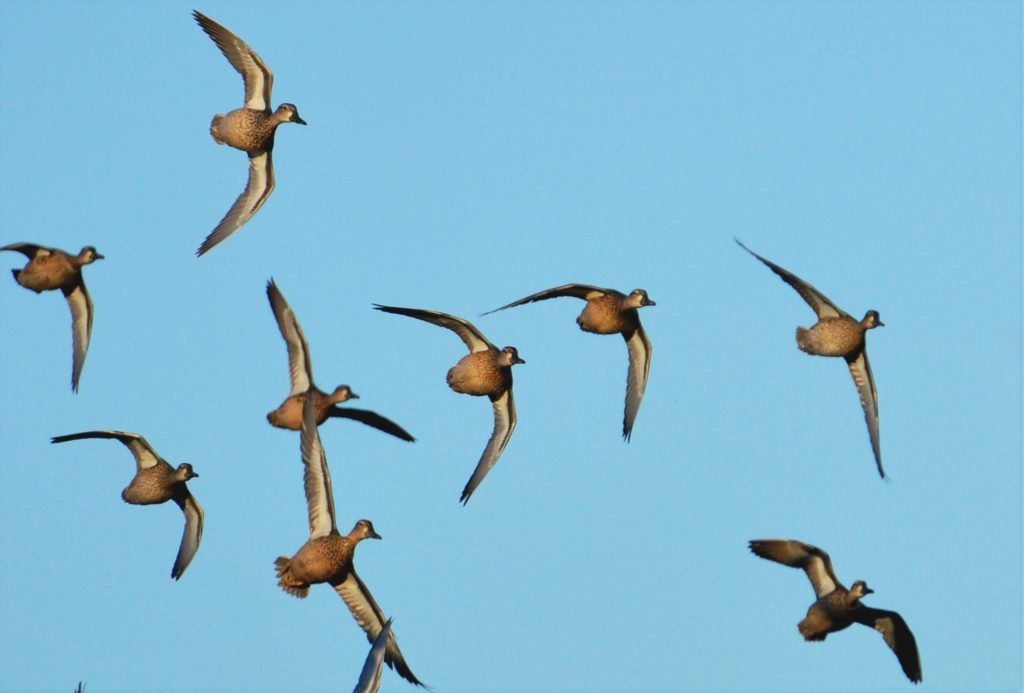Photography courtesy of Lowell Washburn, all rights reserved.
Iowa’s September teal season is the best thing that’s happened to duck hunting in the past half century. Timed to take advantage of early migrating blue-winged teal, the season is offered to Mississippi Flyway states by the U.S. Fish & Wildlife Service as a sixteen-day, teal only bonus hunt. The special season is referred to as a bonus because the sixteen days are not subtracted from Iowa’s “regular”, sixty-day duck seasons. The math is simple. Iowa teal seasons turn a normally scheduled, 60-day duck season into one that runs for 76-days.

Blue-winged teal are the very first waterfowl to depart their prairie nesting grounds each year. Adult males are the first to wing southward, followed by hens and juveniles. No species travels faster and farther down the flyways. Blue-wings banded during early September at Winnebago County’s Rice Lake were recovered within weeks by hunters from as far away as Jamaica, Guatemala, and Columbia. After spending the summer on Canadian wetlands, large numbers of adult males often arrive on the marshes of coastal Louisiana during the first week of September. Although current teal numbers remain well above the Fish & Wildlife Service’s long-term, 60-year survey average, the majority of blue-wings have already migrated through northern states like Iowa, Minnesota, and Wisconsin long before traditional hunting seasons begin.
There are a lot of good reasons for waterfowl enthusiasts to take advantage of Iowa’s early teal migration. First and foremost, blue-winged teal are an “equal opportunity” game bird. They inhabit wetlands of all shapes and sizes. As long as adequate food is present, teal are equally at home on our largest permanent marshes as well as on the tiniest walk-in potholes. Successfully hunting them can be as complicated as employing blind boats and big spreads, or as simple as grabbing a light bag of decoys and pulling on a pair of hip boots.

Regardless of how you choose to go at it, teal hunting provides high quality outdoor recreation that is available to all ages and all levels of expertise. With mild temperatures and an overwhelming abundance of viewable wetland wildlife, there is no better way to introduce young people to the incredible world of waterfowling.
Although teal are exceptionally fast, they are not exceptionally bright. And while flocks will readily come to decoys, successfully bagging them once they get there presents a challenge. Hog fat and in prime condition, those that are bagged provide excellent table fare. Grilled, fried, smoked, or slow baked; blue-winged teal are melt in your mouth delicious. The Iowa teal season runs through September 16.

 Susan Judkins Josten
Susan Judkins Josten Rudi Roeslein
Rudi Roeslein Elyssa McFarland
Elyssa McFarland Mark Langgin
Mark Langgin Adam Janke
Adam Janke Joe Henry
Joe Henry Sue Wilkinson
Sue Wilkinson Tom Cope
Tom Cope Kristin Ashenbrenner
Kristin Ashenbrenner Joe Wilkinson
Joe Wilkinson Dr. Tammy Mildenstein
Dr. Tammy Mildenstein Sean McMahon
Sean McMahon